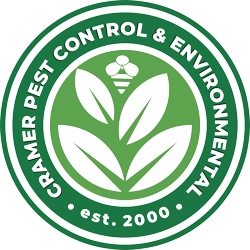Does water damage mean mold?
Water damage is one of the scariest things a homeowner can experience. The idea of soggy carpets or floodwaters pouring into your house is understandably anxiety inducing – but does water damage always mean mold?
The short answer is: it depends on how quickly you get your home dried out! For the more complete answer, keep reading to see what you need to know about water damage and mold remediation.
How long does it take for mold to grow from water damage?
According to the Federal Emergency Management Agency (FEMA), mold can begin to grow within 24 to 48 hours of water exposure. This is a shockingly short amount of time and is the reason that it is absolutely essential to respond to water damage ASAP!
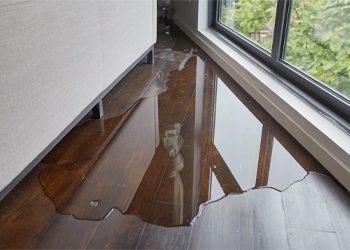
Can a one time water leak cause mold?
While not every instance of water intrusion will inevitably result in mold, the reality is that mold spores are found everywhere and it is very likely that any large scale water damage will cause mold.
If you are able to thoroughly dry the impacted areas the likelihood of mold is greatly reduced. Impermeable materials, like tile, metal, and glass, are less likely to experience mold growth and when it occurs it is less serious. However, many materials commonly found in the home like wood, drywall, carpet, and insulation soak up water and are a perfect breeding ground for mold.
What types of water leaks can cause mold growth?
Roof Leaks
Your roof plays a vital role in keeping your home safe from the elements, and if it fails the results can be catastrophic. The problem with roof leaks are twofold:
First, roof leaks tend to only be noticed (or addressed) when they are severe. A small leak might not be obvious, but moisture intrusion (and thus the possibility for mold growth) is happening. Severe leaks draw attention to themselves, but in the process introduce possibly hundreds of gallons of water into your home.
Second, and just as important: gravity works against you in roof leaks. While a leak in your basement is destructive, the damage will generally remain confined to your basement. A roof leak, on the other hand, will take the path of least resistance down from your attic, through your walls, soaking and damaging framing, drywall, and insulation as it goes.
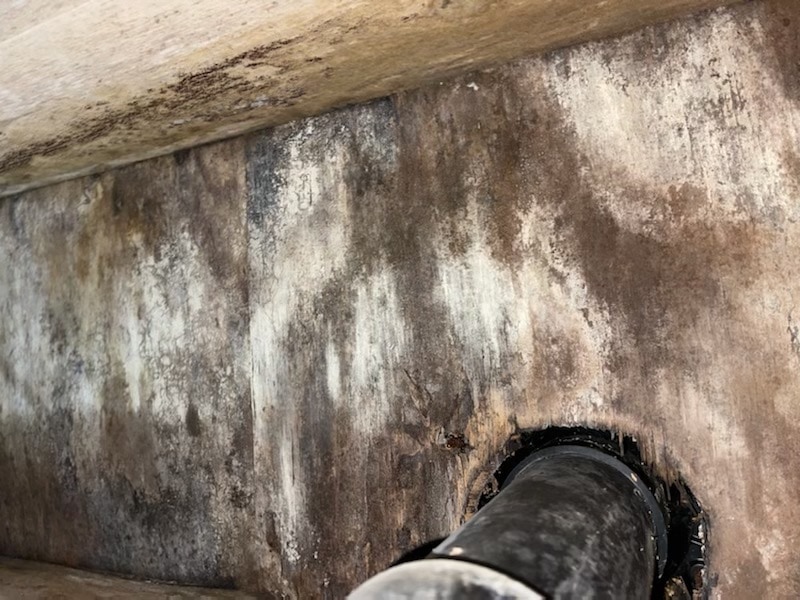
Flooding
Unlike roof damage, floods are about as obvious a disaster as they come. When your home is hit by a flood it’s time to start thinking about water damage restoration!
Flood waters may take hours or even days to recede, and often leave behind a layer of damp silt which may contain heavy metals or human waste. Ideally, you’ll want to contact a professional restoration company for flood recovery, but if you are starting with a DIY approach be sure to wear protective gear!
Depending on how your home is situated, you may need to pump flood waters out of your basement or crawlspace – don’t let water sit there for a minute longer than it has to!

Malfunctioning HVAC Units
When in use, HVAC units create condensation. When working correctly, air conditioning units route this condensation away using a combination of a drip tray and drainage lines, preventing mildew and mold problems from developing.
However, it is possible for your drainage lines to clog or for your drip tray to shift out of position, resulting in a leak. Depending on the severity of the leak, it may be immediately obvious that something is wrong, or your first signs of a problem might be visible mold!
Getting your HVAC system serviced regularly offers some protection against this threat, but the unfortunate reality is that these problems are hard to detect in their earliest stages.

Plumbing Leaks
Plumbing leaks range from catastrophic events that are impossible to miss, to leaky drains that might go unnoticed for days, weeks, or even months. Both extremes (and the situations in between) can lead to mold growth, although bigger leaks represent a bigger problem.
Remember, even small leaks if left unchecked, will inevitably lead to mold. Don’t put off minor plumbing problems until later – because there is a good chance they won’t be minor problems in the future!
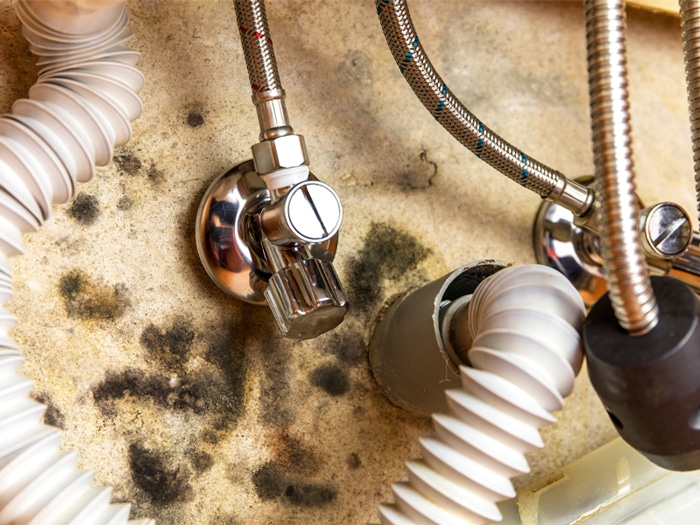
How does mold damage a home?
Mold is more than just unpleasant to look at – it actually damages the materials it is present on. The reason for this is simple: mold grows by digesting organic matter! In nature, this is good, and prevents dead organisms from endlessly piling up. However, in our homes this can cause permanent damage to drywall and carpets – and can even cause structural damage!
Can mold cause health problems?
While mold can cause structural damage to our homes, the biggest risk associated with indoor mold is its impact on our health. Certain species of mold produce toxins which can cause respiratory issues, and even less toxic molds can cause allergic reactions in sensitive individuals.
Common health effects of mold exposure include:
- Nasal congestion
- Sore throat
- Coughing
- Eye irritation / itchy or burning eyes
- Skin rash
- Respiratory problems including asthma
What are the signs of mold?
Mold can be incredibly easy to spot – or it can hide in dark and inaccessible places, growing undetected.
When visible, it usually appears as dark spots on porous surfaces which slowly spread out. The spots can range in color from white to orange to black. While toxic black mold gets most of the media coverage – mold of any color needs to be removed ASAP!
When behind walls or beneath cabinets, mold is usually most noticeable by its distinctive musty odor. Imagine the smell of an old home’s basement – that smell is usually caused by mold. If this smell develops in your home it is a sign of a problem!
Finally, any signs of water damage should be taken to indicate the risk of mold. Staining on drywall and ceilings or warped wood all suggest that mold might be in development.
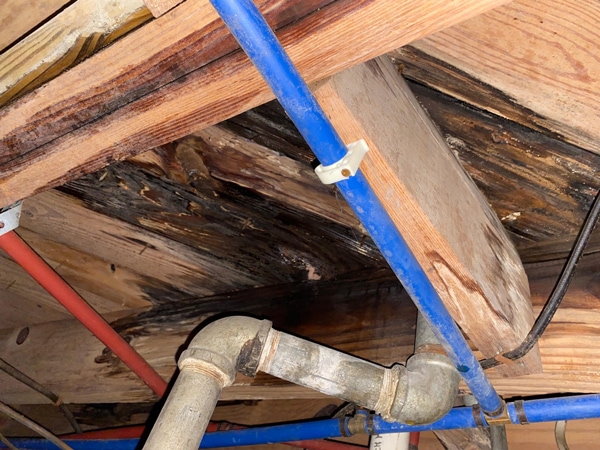
Preventing mold growth
The simplest way to prevent mold is to keep your home dry! Promptly fix leaks, and if leaks do occur make sure that you dry out the impacted areas as quickly as possible. Major leaks may require professional grade dehumidifiers and fans, while minor leaks can be treated with good airflow and a residential grade dehumidifier.
Even without leaks, mold will develop in humid environments. Make sure that your attic, crawlspace, basement, laundry room, and bathrooms are well ventilated and that indoor relative humidity levels stay between 30 and 50%.
After water damage takes place it is essential to take mold remediation steps. Depending on the size of the impacted area this may be a DIY job, but more generally you should hire a professional. Many of the chemicals used to prevent or kill mold, like bleach, pose health risks when used without protective gear and proper training.
Water Damage and Mold
The unfortunate reality of water damage is that in most cases you should anticipate a mold infestation to follow. It is hard to dry out homes quickly enough to prevent mold and mildew from beginning to grow, and so mold remediation should be a part of any water damage clean up.
If you have small leaks or perpetually damp areas in your home, it is essential to address them before they have time to turn into mold which will impact you and your family’s health.
